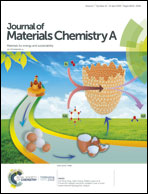Highly stable lithium–sulfur batteries based on p–n heterojunctions embedded on hollow sheath carbon propelling polysulfides conversion†
Abstract
Newly-developed lithium–sulfur batteries (LSBs) have been supposed to be extremely promising devices as they deliver a high theoretical energy of 2600 W h kg−1. Utilizing sulfur as the cathode material is advantageous due to its low price, non-toxicity, and abundant resources. The main bottleneck hindering the practical application of LSBs is their poor cycling performance due to the shuttling of soluble lithium polysulfides (LiPSs), poor conductivity, and sluggish redox reaction. Herein, we prepared a new type of p–n heterostructure embedded into carbon hollow nanosheet arrays grown on carbon cloth by subsequent sulfidation and nitridation. The hollow heterostructures can sufficiently restrict the dissolution of LiPSs due to the polar chemisorption and physical confinement, and facilitate polysulfide redox kinetics (Li2Sx → Li2S, 2 ≤ x ≤ 8). The abundant active sites and boundary defects constructed by the Co9S8–Co4N heterostructures improve the nucleation/conversion redox kinetics of Li2S. Also, the hollow structure can increase the sulfur loading and supply enough space for relieving the volume expansion during the whole cycling process. After melting the diffused sulfur of the nanocomposites, the resulting free-standing S/CC@Co9S8–Co4N electrode exhibits a highly stable cycling rate with an ultralow capacity fading rate of 0.027% per cycle at 5.0C over 1000 cycles. Our work provides a potential avenue for constructing heterostructured materials for LSBs with high performance.



 Please wait while we load your content...
Please wait while we load your content...